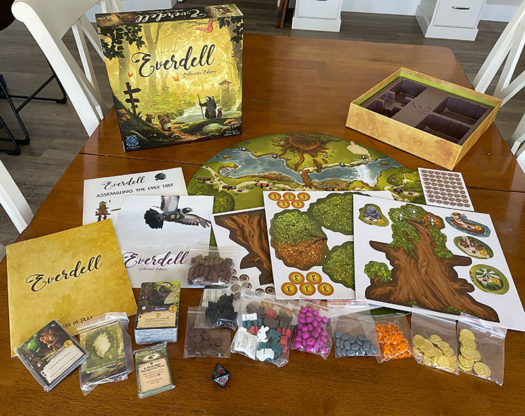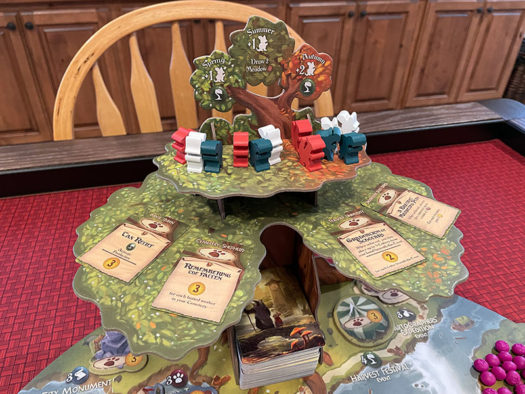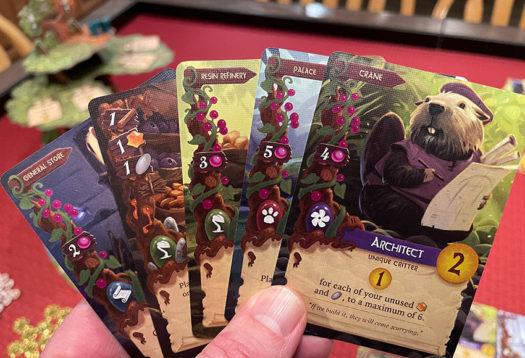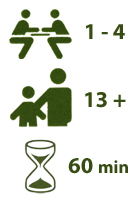Everdell Board Game Review

“Within the charming valley of Everdell, beneath the boughs of towering trees, among meandering streams and mossy hollows, a civilization of forest critters is thriving and expanding. There are buildings to construct, lively characters to meet, events to host—you have a busy year ahead of yourself. Will the sun shine brightest on your city before the winter moon rises?
Prepare to be enchanted by the wondrous world of Everdell. Once you are here, you might never, ever, want to leave.”
Such is the intro text to the board game Everdell by Starling Games.
The big question is, is it true – Once you enter and play, will you ever want to leave?

How to play Everdell
Everdell is a worker-placement board game with tableau-building. What this means is that players send their “workers” (hedgehogs, mice, squirrels, turtles) to different locations on the board to take different actions. They’ll also collect and play cards in front of them in a growing city to use the abilities from those cards (immediately or in the future, or both).

The objective in Everdell is to earn the most points by building a thriving city before winter sets in.
The game flow is rather simple. Yet, the choices seem endless.
On a player’s turn, they perform only 1 of 3 actions.
- Place a Worker
- Play a Card
- Prepare for the next Season
After a player has performed their 1 action, play moves to the next player.
Here’s a look at the possible actions in more detail.

Place a Worker
Each player starts the game with 2 workers of their chosen type (hedgehogs are brown, turtles are green, squirrels are orange, and mice are white) and will gain more at the start of each season. These additional workers are set up on the top level of the Ever Tree to start the game. By the final season, players will have 6 workers to send out to take actions.
If a player chooses to place one of their workers, there are many locations on the board to choose from. These include:
- Basic locations where players can gain resources (twigs, resin, boulders, and berries).
- Forest locations which are the small cards on the board that grant different abilities.
- Event locations (basic tiles or special cards) if the player meets the requirements.
- The Haven where players can exchange 2 cards for 1 resource.
- The Journey area where players discard cards for points.
- Destination cards that have an “Open” symbol.
Some locations may only be occupied by 1 worker and some locations may hold multiple workers.

Play a Card
A player may play 1 card for this action. To play a card to their area, a player must pay the listed requirements on the card (symbols listed in the top left corner of the card).
Players may play a card from their hand or from the Meadow (the area on the board with 8 cards on display).
Cards are either Critters or Constructions and come in 5 different types. Critters usually cost berries to come into a player’s city. But some may also be played for free if the indicated Construction card is already in the city. For example, the Judge may be played for free is the Courthouse is already in the player’s city.
Each player’s city may only hold a maximum of 15 cards. Players also have a hand limit of 8 cards during play.

Prepare for the next Season
If a player has placed all of their workers and cannot play a card (or do not wish to), they must prepare for the next season. To do so, players retrieve all of their workers from their locations and then gains the bonus listed on the Ever Tree for the next season.
- In Spring, players gain 1 new worker and activate all the green Production cards in their city.
- In Summer, players gain 1 new worker and may draw up to 2 Meadow cards.
- In Autumn, players gain their final 2 workers and activate all the green Production cards in their city.
Also, players do not have to perform Prepare for next Season at the same time.

Game End
When a player has reached the end of Autumn and cannot perform any more actions (or doesn’t wish to), they have finished the game and must pass. They also may not be given any cards or resources. Any unfinished players continue taking turns until all have passed.
Then players add up their points:
- Base points from cards in their city
- Point tokens
- Prosperity card bonus points
- Journey points
- Event points
The player with the most points wins!

Solo Play
Everdell can also be played in Solo mode. When doing so, the player competes against a “cantankerous old rodent known as Rugwort and his pack of rowdy, rambunctious, rat ruffians.
There are 3 levels of difficulty in solo mode – known as Years (to keep with the seasons theme).
Essentially, Rugwort’s workers will block some of the different locations each season. Also, when a player plays a card, Rugwort gets to play a card as well. The player rolls the 8-sided die and the result is the card that Rugwort plays from the Meadow.
After Preparing for the next Season, Rugwort also prepares for the next season. If the cards Rugwort has meet the requirements for an Event, Rugwort achieves that Event. Rugwort’s new worker also gets placed on a Meadow card – blocking it from being played by the player for the rest of the game.
For scoring at the end of the game, Rugwort scores 2 points for every card in his city, 3 points for each basic Event, 3 points for each Special Event that the player didn’t achieve, 3 points for his Journey, and any point tokens given him by the player.
Again, whoever has the most points wins – either the player or Rugwort.

Can the whole family enjoy Everdell?
The first thing everyone notices about Everdell is the massive tree.
The Ever Tree is fantastic at drawing players into the world of Everdell. Yet it’s the game play that keeps them coming back.
(Okay, maybe the great artwork on all the cards and cute animal meeples plays a role in that too.)

The published recommended age for Everdell is 13+ and we can see why.
Even though the basic flow is simple – of placing a worker, playing a card, or preparing for the next season – there are many choices throughout the game. And with over 120 cards in the deck, that also means there are tons of options when it comes to just playing the cards.
Sure there are many copies of different critters and constructions, but there will still always be a ton of options on the cards both in a player’s hand and in the Meadow.

Once a player has chosen the different cards they want to play into their city, they’ll have to go get those resources. And that brings to play many other choices – where to place their workers to get the resources they need.
Plus, players will need to continuously adjust their plans as opponents block locations and take Meadow cards they have their eyes on.
So while it’s nice that a player’s turn only consists of 1 action to keep the game moving along, it may take players a bit of time to decide what to do next.

Everdell is a board game that rewards repeated plays.
The vast amount of cards and possible chaining combinations essentially requires repeat play. That’s because familiarity with the cards and their abilities is the centerpiece of the game. Once players become better familiar with the cards in the mix, they’ll be able to plan out their options better. And in doing so, they’ll come to enjoy the game much more.


Repeat plays will also help players work around the Ever Tree’s table presence.
Wait, isn’t the Ever Tree supposed to be a high point of the game?
Well, it may be great from a visual and thematic standpoint. But from a functional standpoint, it’s kind of a hindrance.
Why?
Because players really can’t sit behind the tree to play the game.
Players really need to be in front of the tree to see the cards in the Meadow and place their workers. And since players can play up to 15 cards in their city, a 4-player game takes up a lot of table space in front of the tree and board.
And when players are that spaced out, they’ll often need to stand and lean in close to be able to read the abilities of the cards in the Meadow to make their decisions.
But once players are more familiar with the types of cards and their associated abilities, there will be less standing to get a closer look at the cards and locations on the board.
So if you like worker-placement games, building up your tableau of cards with combos, and a fun them with fantastic artwork, then Everdell is definitely a game to dive into and see if you’ll ever want to leave.

Do we ever want to leave Everdell?
 We love games that draw us into a new world while we play. And Everdell definitely delivers on that. We totally enjoy sending our mice, squirrels, turtles, and hedgehogs out to gather resources and help us build out our forest cities.
We love games that draw us into a new world while we play. And Everdell definitely delivers on that. We totally enjoy sending our mice, squirrels, turtles, and hedgehogs out to gather resources and help us build out our forest cities.
And we absolutely love the artwork and tactile joy of the twigs, boulders, resin gems, and rubber berries. They’re so nice to use for resources that it further pulls us right into the forest realm.
While our first few plays took much longer to get through, the reward of repeat plays pays off nicely.
The Board Game Family would like to thank Starling Games for a review copy of Everdell.





